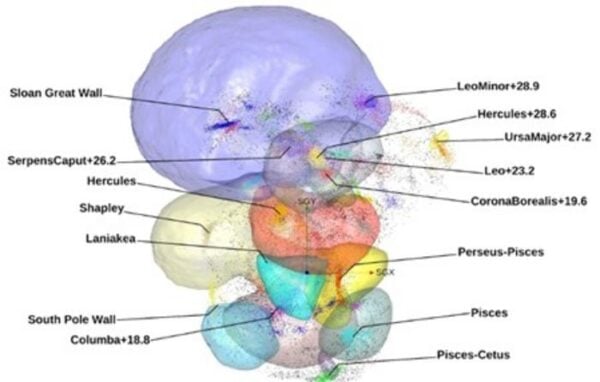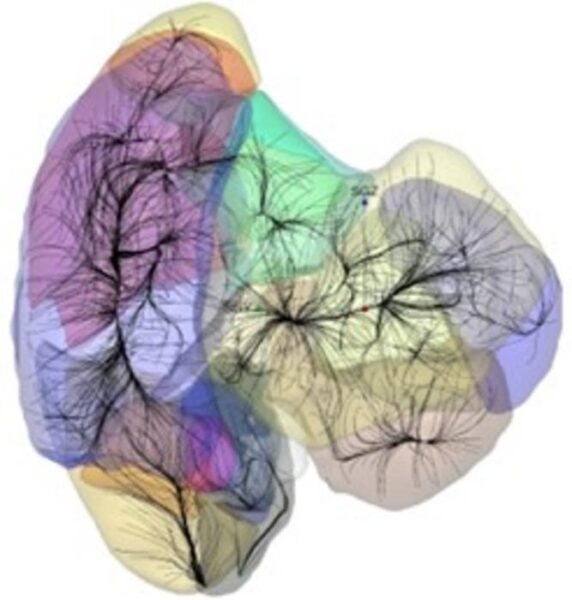An international team of researchers has unveiled a groundbreaking map of the gravitational landscape in our local Universe, revealing massive structures that shape the movement of galaxies on a cosmic scale.
Summary: Using advanced data and algorithms, scientists have identified key gravitational regions in the Universe, including the massive Sloan Great Wall, offering new insights into cosmic structure and evolution.
Estimated reading time: 5 minutes
A new study published in Nature Astronomy has provided an unprecedented look into the gravitational forces shaping our Universe. Using data from the Cosmicflows-4 (CF4) compilation, which includes information on roughly 56,000 galaxies, researchers have mapped out the “basins of attraction” – regions where gravity dominates and influences the movement of cosmic structures.
This research, led by Dr. Valade and involving scientists from the Hebrew University of Jerusalem, AIP Potsdam, the University of Paris-Saclay, and the University of Hawaii, has potentially shifted our understanding of our galaxy’s place in the cosmos and revealed new insights into the largest structures in the observable Universe.
Unveiling the Cosmic Landscape
The study is grounded in the Lambda Cold Dark Matter (ΛCDM) standard model of cosmology, which posits that the Universe’s structure emerged from quantum fluctuations during cosmic inflation. These tiny variations in density grew over time, forming the galaxies and clusters we see today.
Using a sophisticated Hamiltonian Monte Carlo algorithm, the team reconstructed the large-scale structure of the Universe up to a distance of about a billion light years. This method allowed them to identify and analyze the most significant gravitational basins of attraction that govern galactic movement.
One of the most striking findings is the identification of the Sloan Great Wall as the largest basin of attraction in the observed region. This cosmic behemoth encompasses a volume of about half a billion cubic light years, more than twice the size of the previously recognized largest structure, the Shapley basin.
Reshaping Our Cosmic Neighborhood
The new data from CF4 has also prompted a reevaluation of our Milky Way’s cosmic address. Previous studies using earlier Cosmicflows catalogues had placed our galaxy within a region called the Laniakea Supercluster. However, the latest analysis suggests that Laniakea might actually be part of the much larger Shapley basin of attraction.
This finding underscores the dynamic nature of our understanding of cosmic structure and highlights the importance of ongoing observational efforts in refining our cosmic maps.

Implications for Cosmology and Beyond
The identification of these massive basins of attraction offers new insights into the gravitational dynamics that have shaped the Universe’s structure over billions of years. By mapping out these regions, scientists can better understand how galaxies and cosmic structures evolve and interact over time.
This research has potential implications for our understanding of dark matter distribution, cosmic expansion, and the fundamental forces that govern the Universe. It may also guide future astronomical research and help refine our cosmological models.
Questions and Future Research
While this study represents a significant advance in our understanding of cosmic structure, it also raises new questions:
- How do these basins of attraction influence the distribution and properties of dark matter?
- What role do these structures play in the ongoing expansion of the Universe?
- How might future, more sensitive surveys refine or alter our understanding of these cosmic structures?
As observational techniques and data analysis methods continue to improve, future research will likely provide even more detailed maps of our cosmic neighborhood, potentially revealing new structures and dynamics on even larger scales.
Quiz
- What is the largest basin of attraction identified in this study?
- How far out did the researchers map the Universe’s structure in this study?
- What model of cosmology does this research support?
Answers:
- The Sloan Great Wall
- About a billion light years
- The Lambda Cold Dark Matter (ΛCDM) standard model
Further Reading
Glossary of Terms
- Basins of Attraction: Regions in space where gravity dominates, influencing the movement of galaxies and matter.
- Cosmicflows-4 (CF4): A compilation of distances and velocities for approximately 56,000 galaxies used in this study.
- Lambda Cold Dark Matter (ΛCDM) Model: The current standard model of cosmology that explains the structure and evolution of the Universe.
- Hamiltonian Monte Carlo Algorithm: An advanced computational method used to reconstruct the Universe’s structure in this study.
- Quantum Fluctuations: Tiny variations in energy or matter at the quantum scale, believed to be the seeds of cosmic structure.
- Supercluster: A large group of smaller galaxy clusters or galaxy groups; one of the largest known structures in the Universe.
Enjoy this story? Get our newsletter! https://scienceblog.substack.com
If our reporting has informed or inspired you, please consider making a donation. Every contribution, no matter the size, empowers us to continue delivering accurate, engaging, and trustworthy science and medical news. Independent journalism requires time, effort, and resources—your support ensures we can keep uncovering the stories that matter most to you.
Join us in making knowledge accessible and impactful. Thank you for standing with us!

